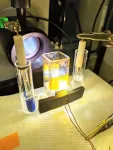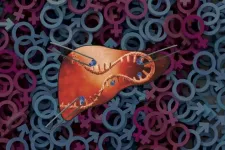Making clean hydrogen is hard, but researchers just solved a major hurdle
2021-07-19
(Press-News.org) For decades, researchers around the world have searched for ways to use solar power to generate the key reaction for producing hydrogen as a clean energy source -- splitting water molecules to form hydrogen and oxygen. However, such efforts have mostly failed because doing it well was too costly, and trying to do it at a low cost led to poor performance.
Now, researchers from The University of Texas at Austin have found a low-cost way to solve one half of the equation, using sunlight to efficiently split off oxygen molecules from water. The finding, published recently in Nature Communications, represents a step forward toward greater adoption of hydrogen as a key part of our energy infrastructure.
As early as the 1970s, researchers were investigating the possibility of using solar energy to generate hydrogen. But the inability to find materials with the combination of properties needed for a device that can perform the key chemical reactions efficiently has kept it from becoming a mainstream method.
"You need materials that are good at absorbing sunlight and, at the same time, don't degrade while the water-splitting reactions take place," said Edward Yu, a professor in the Cockrell School's Department of Electrical and Computer Engineering. "It turns out materials that are good at absorbing sunlight tend to be unstable under the conditions required for the water-splitting reaction, while the materials that are stable tend to be poor absorbers of sunlight. These conflicting requirements drive you toward a seemingly inevitable tradeoff, but by combining multiple materials -- one that efficiently absorbs sunlight, such as silicon, and another that provides good stability, such as silicon dioxide -- into a single device, this conflict can be resolved."
However, this creates another challenge -- the electrons and holes created by absorption of sunlight in silicon must be able to move easily across the silicon dioxide layer. This usually requires the silicon dioxide layer to be no more than a few nanometers, which reduces its effectiveness in protecting the silicon absorber from degradation.
The key to this breakthrough came through a method of creating electrically conductive paths through a thick silicon dioxide layer that can be performed at low cost and scaled to high manufacturing volumes. To get there, Yu and his team used a technique first deployed in the manufacturing of semiconductor electronic chips. By coating the silicon dioxide layer with a thin film of aluminum and then heating the entire structure, arrays of nanoscale "spikes" of aluminum that completely bridge the silicon dioxide layer are formed. These can then easily be replaced by nickel or other materials that help catalyze the water-splitting reactions.
When illuminated by sunlight, the devices can efficiently oxidize water to form oxygen molecules while also generating hydrogen at a separate electrode and exhibit outstanding stability under extended operation. Because the techniques employed to create these devices are commonly used in manufacturing of semiconductor electronics, they should be easy to scale for mass production.
The team has filed a provisional patent application to commercialize the technology.
Improving the way hydrogen is generated is key to its emergence as a viable fuel source. Most hydrogen production today occurs through heating steam and methane, but that relies heavily on fossil fuels and produces carbon emissions.
There is a push toward "green hydrogen" which uses more environmentally friendly methods to generate hydrogen. And simplifying the water-splitting reaction is a key part of that effort.
Hydrogen has potential to become an important renewable resource with some unique qualities. It already has a major role in significant industrial processes, and it is starting to show up in the automotive industry. Fuel cell batteries look promising in long-haul trucking, and hydrogen technology could be a boon to energy storage, with the ability to store excess wind and solar energy produced when conditions are ripe for them.
Going forward, the team will work to improve the efficiency of the oxygen portion of water-splitting by increasing the reaction rate. The researchers' next major challenge is then to move on to the other half of the equation.
"We were able to address the oxygen side of the reaction first, which is the more challenging part, " Yu said, "but you need to perform both the hydrogen and oxygen evolution reactions to completely split the water molecules, so that's why our next step is to look at applying these ideas to make devices for the hydrogen portion of the reaction."
INFORMATION:
This research was funded by the U.S. National Science Foundation through the Directorate for Engineering and the Materials Research Science and Engineering Centers (MRSEC) program. Yu worked on the project with UT Austin students Soonil Lee and Alex De Palma, along with Li Ji, a professor at Fudan University in China.
[Attachments] See images for this press release:

ELSE PRESS RELEASES FROM THIS DATE:
2021-07-19
GAINESVILLE, Fla. --- Plants are DNA hoarders. Adhering to the maxim of never throwing anything out that might be useful later, they often duplicate their entire genome and hang on to the added genetic baggage. All those extra genes are then free to mutate and produce new physical traits, hastening the tempo of evolution.
A new study shows that such duplication events have been vitally important throughout the evolutionary history of gymnosperms, a diverse group of seed plants that includes pines, cypresses, sequoias, ginkgos and cycads. Published today in Nature Plants, the research indicates that ...
2021-07-19
FINDINGS
A chemical modification that occurs in some RNA molecules as they carry genetic instructions from DNA to cells' protein-making machinery may offer protection against non-alcoholic fatty liver, a condition that results from a build-up of fat in the liver and can lead to advanced liver disease, according to a new study by UCLA researchers.
The study, conducted in mice, also suggests that this modification -- known as m6A, in which a methyl group attaches to an RNA chain -- may occur at a different rate in females than it does in males, potentially explaining why females tend to have higher fat content in the liver. The researchers found that without the m6A modification, differences in liver fat content between the sexes were reduced dramatically.
In ...
2021-07-19
WOODS HOLE, Mass. - What's a hungry marine microbe to do when the pickings are slim? It must capture nutrients - nitrogen, phosphorus, or iron - to survive, yet in vast expanses of the ocean, nutrients are extremely scarce. And the stakes are high: Marine microbial communities drive many of the elemental cycles that sustain all life on Earth.
One ingenious solution to this challenge is reported this week in Proceedings of the National Academy of Sciences. In low-nutrient environments, marine microbes can clump together and hook up with even tinier cells that have vibrating, hairlike appendages (cilia) on their surface. ...
2021-07-19
New York, NY--July 19, 2021-- A new robotic neck brace from researchers at Columbia Engineering and their colleagues at Columbia's Department of Otolaryngology may help doctors analyze the impact of cancer treatments on the neck mobility of patients and guide their recovery.
Head and neck cancer was the seventh most common cancer worldwide in 2018, with 890,000 new cases and 450,000 deaths, accounting for 3% of all cancers and more than 1.5% of all cancer deaths in the United States. Such cancer can spread to lymph nodes in the neck, as well as other organs in the body. Surgically removing lymph nodes in the neck can help doctors investigate the risk of spread, but may result in pain and stiffness in the shoulders and neck for years afterward.
Identifying ...
2021-07-19
CT scans for patients with concussion provide critical information about their risk for long-term impairment and potential to make a complete recovery - findings that underscore the need for physician follow-up.
In a study led by UC San Francisco, researchers looked at the CT scans of 1,935 patients, ages 17 and over, whose neurological exams met criteria for concussion, or mild traumatic brain injury (TBI), at hospitals throughout the nation. While links between CT imaging features and outcome have already been established in moderate and severe TBI, the researchers believe this is the first time the link has been identified in patients ...
2021-07-19
Hamilton, ON (July 19, 2021) - A potentially game-changing treatment for people with, or at risk of, blood clots has been found effective by an international team of researchers led by McMaster University's Jeffrey Weitz.
Weitz's team compared abelacimab with enoxaparin as a control drug in 412 patients undergoing knee replacement surgery. Results showed that just one abelacimab injection prevents blood clots for up to a month after surgery, reducing the risk by about 80% compared with enoxaparin without increasing the risk of bleeding.
Their findings were published in the New England Journal of Medicine today, coinciding with Weitz's presentation of the research at the International Society on Thrombosis and Hemostasis 2021 Congress.
Weitz, a hematologist, is a professor of medicine ...
2021-07-19
What The Study Did: This study investigated the association between time spent cycling and the risk of death from cardiovascular disease or any other cause among people with diabetes.
Authors: Mathias Ried-Larsen, Ph.D., of Rigshospitalet in Copenhagen, is the corresponding author.
To access the embargoed study: Visit our For The Media website at this link https://media.jamanetwork.com/
(doi:10.1001/jamainternmed.2021.3836)
Editor's Note: The article includes conflicts of interest and funding/support disclosures. Please see the article for additional information, including other authors, author contributions and affiliations, conflict of interest and financial disclosures, and funding and support.
# # #
Media advisory: The full study and editor's note are ...
2021-07-19
What The Study Did: The experiences, perspectives and needs of transgender young people in accessing health care are described in this review of 91 studies.
Authors: Lauren S. H. Chong, M.D., of the Children's Hospital at Westmead in Sydney, Australia, is the corresponding author.
To access the embargoed study: Visit our For The Media website at this link https://media.jamanetwork.com/
(doi:10.1001/jamapediatrics.2021.2061)
Editor's Note: The article includes conflict of interest disclosures. Please see the article for additional information, including other authors, author contributions and affiliations, conflict of interest and financial disclosures, and funding and support.
# ...
2021-07-19
What The Study Did: These results suggest that substantial proportions of Latinx immigrants have immigration concerns about engaging in COVID-19-related testing, treatment and contact tracing.
Authors: Carol L. Galletly, J.D., Ph.D., Medical College of Wisconsin in Milwaukee, is the corresponding author.
To access the embargoed study: Visit our For The Media website at this link https://media.jamanetwork.com/
(doi:10.1001/jamanetworkopen.2021.17049)
Editor's Note: The article includes conflict of interest and funding/support disclosures. Please see the article for additional information, including other authors, author contributions and affiliations, conflict of interest and financial disclosures, and funding and support.
# # ...
2021-07-19
What The Study Did: The association between daily coffee consumption and the risk of cardiac arrhythmias was evaluated in this study.
Authors: Gregory M. Marcus, M.D., M.A.S., of the University of California, San Francisco, is the corresponding author.
To access the embargoed study: Visit our For The Media website at this link https://media.jamanetwork.com/
(doi:10.1001/jamainternmed.2021.3616)
Editor's Note: The article includes conflicts of interest and funding/support disclosures. Please see the article for additional information, including other authors, author contributions and affiliations, conflict of interest and financial disclosures, and funding and support.
# # #
Media advisory: The full study and commentary are ...
LAST 30 PRESS RELEASES:
[Press-News.org] Making clean hydrogen is hard, but researchers just solved a major hurdle



